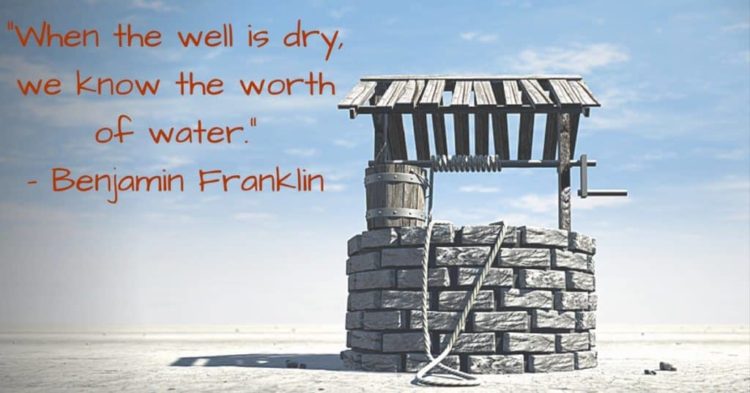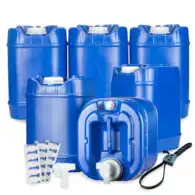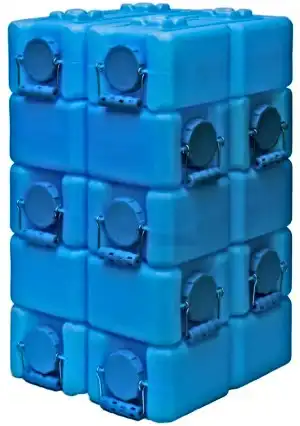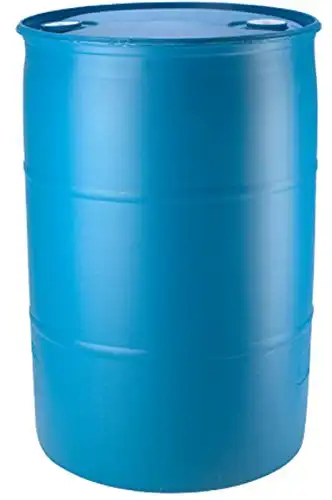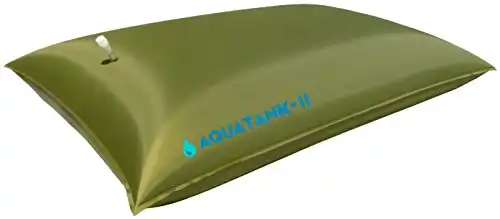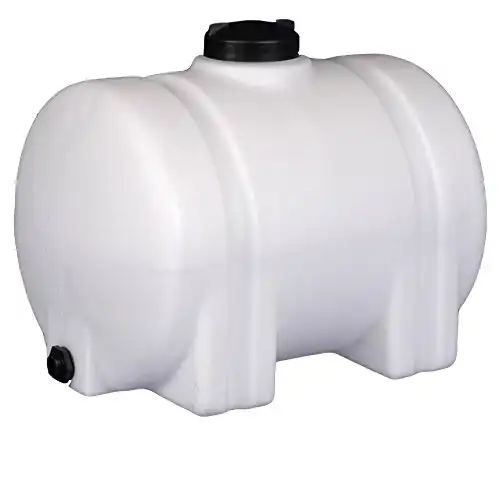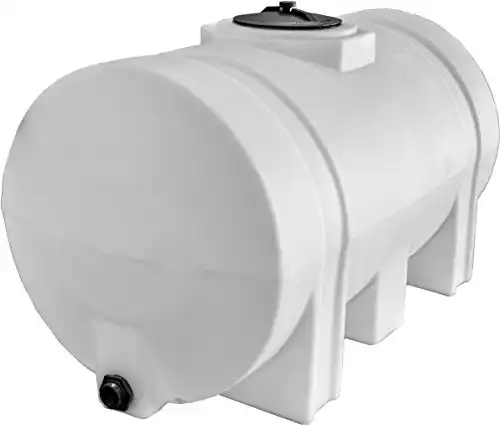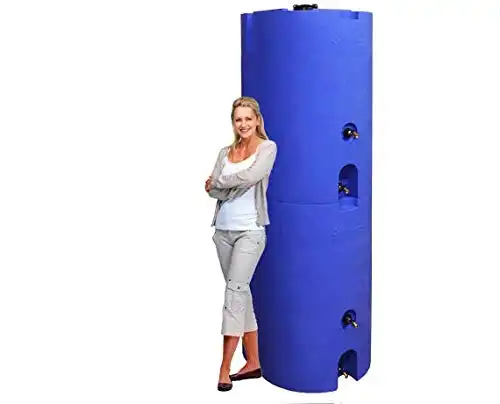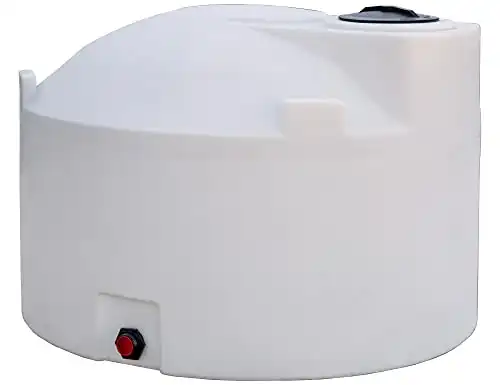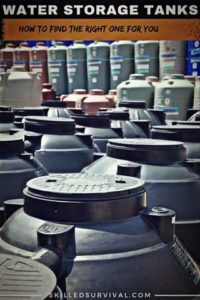
A Complete Guide To Finding (& Setting Up) A Water Tank Storage System
Because water is the source of all life on Earth.
- Without it, anything living dies
- Without it, there would be no civilizations
- No people, no plants, no animals
- No chance of survival
- Nothing but inorganic stone and wind
Water is the-most-essential resource known to man.
In fact, we’re so dependent on it, it can be described as a burdensome necessity…
- It’s heavy
- It’s easily contaminated
- It evaporates over time
- Dehydration kills
That’s why everyone, whether you’re a prepper or not, should keep a supply of backup water.
When disaster strikes, it often takes out municipal water systems and electricity grids first.
And if that goes down, your access to clean drinkable water goes out the window.
Unless, of course, you have stored water at home.
TOPICS IN THIS GUIDE… ↓(click to jump)
- The Coming Water Crisis…
- How Much Should You Store?
- Best Water Storage Tanks Today
- Water Tank Safety Designations
- Adding A Rain Collection System
- How To Maintain Your Tanks
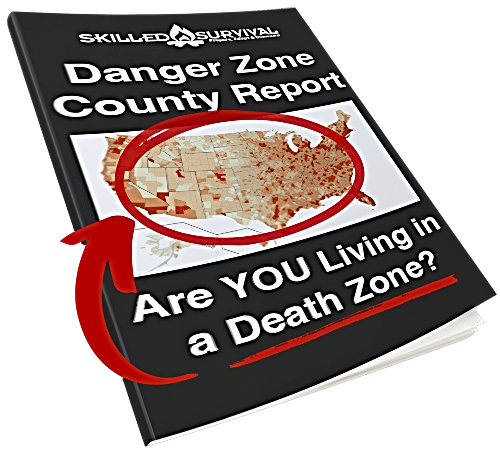
Want a free Danger Zone County Report?
Click here to download this report and see if you're in a Danger Zone County (or not). No purchase necessary.The Coming Water Crisis
There are no two ways about it; the world is facing a water crisis.
↓ The Water Crisis | National Geographic
It may not happen tomorrow or next year, but there’ll be conflicts over freshwater in the future.
In fact, war is simmering on the Indian-Pakistani border over access to fresh water.
And water wars will be ugly conflicts.
Humans will fight for any resource; they can’t live more than a week without it.
The same goes for neighborhoods, towns, and cities worldwide.
When freshwater becomes scarce, people will fight with their lives for it.
Neighbors turning on neighbors and friends turning on friends to get their hands on some.
But you won’t have to because your supply is safe at home, stored in your emergency water storage tanks.
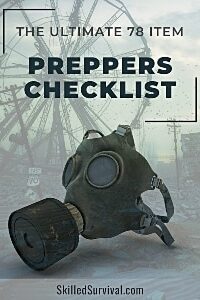
Want a free 78 item prepper checklist?
Click here to instantly download this Complete Checklist PDF. No purchase necessary.How Much Water Should You Store
The answer to “How much water should I store?” differs for everyone.
It’s something that involves many factors:
- Are you storing water for just yourself?
- Or will you be providing water for lots of friends and family members?
- Do you have any pets?
The more people and animals in your household, the more water you should store.
How long do you want your independent water supply to last?
The average person should drink about 1/2 gallon per day (minimum).
That means if you ration it out perfectly, 1 gallon will last you 2 days.
Keep this in mind when shopping for water storage tanks for home.
It will help determine what size/kind of tank you should buy.
At a minimum you should look for a tank that holds enough water to last two weeks.
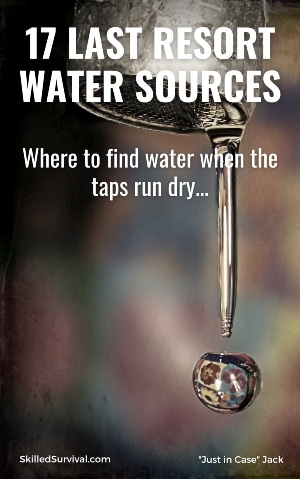
Want a free last resort water checklist?
Click here to instantly download this Complete Checklist. No purchase necessary.Best Emergency Water Storage Tanks For Sale
There are so many different kinds of home water tanks out there…
It can be overwhelming to find the right one.
Big tanks, small tanks, stackable tanks, underground tanks, packable tanks, pillow tanks, etc.
The list is endless, but here are the most popular ones on the market:
Hard-Sided Plastic Water Stackables
Smaller stackables are a good water storage option.
You can build a “wall of water” in your basement.
These are designed to stack neatly on top of open another.
If you stack enough, you get the equivalent of a large water storage tank.
With added portability and space-saving flexibility.
By far my favorite plastic container (and favorite containers overall) is The 5 Gallon Legacy Premium Water Storage System.
Here are a few highlights of these 5-Gallon Water Containers:
- Holds 5 Gallons of Water, Dry Foods, or Ammo
- Stack-able to Maximize Storage Capacity
- Easy-Grip Design Makes it Easy to Carry
- Virtually Indestructible!
They are a solid investment and one of the best long-term survival storage solutions.
Plus, if you get the 30-gallon package (6 containers) you will also get the following bonus features:
- A handy cap wrench (to ensure you completely lock and seal these containers)
- 2 spigots (this allows you to tap into two of the jugs at the same time). This is a nice option if you'd prefer to keep sanitation jugs and consumption jugs separate.
- Water Purification Drop Treatment Solution (the perfect amount for 30 gallons).
NOTE: These are the containers I choose for my own emergency water stockpile – click here to read a detailed review and short “How To” for these containers.
↓ 5-Gallon Water Container – Stackable
A single water brink is far from a tank, but what if you stacked 16 of them?
At 3.5 gallons each, 16 of these would add up to 56 gallons - to me, that's a tank.
Here are a few highlights of the Water Brick:
- It holds 3.5 Gallons of Water, Dry Food, or Ammo
- Stackable To Maximize Storage Capacity
- Easy-Grip Design Makes For Easy Carry
- Virtually Indestructible!
They are a solid investment and one of the best long-term survival water storage solutions.
↓ Water Brick Stackable Water Storage Container Review
Water Barrels
Yes, the’re technically called “barrels” and not “tanks,”.
But they serve a similar purpose.
Storing lots of emergency drinking water at home.
The standard-issue blue plastic barrels are popular.
Because they’re simple and effective.
↓ 55 Gallon Water Barrel
Water Bladders
Much like the bladder inside you, these are stretchable containers.
They fill up like balloons when filled with water.
One important feature of a water bladder is when they’re empty; you can pack them for travel.
Aquatank2 has a water pillow that holds 300 gallons of fluid. This is ideal for keeping inside cars, RVs, campers, and other vehicles.
The Aquatank2 packs away into almost nothing; it’s light and made of highly durable rubber that won't easily rip or tear.
You can also find this same tank in smaller sizes of 60 gallons and 150 gallons.
↓ Water Storage Tank Bladder
Hard-Sided House Water Tank and Cisterns
You need to have space outside for one of these.
But using a cistern system is a huge advantage for two reasons.
- They store A LOT of water (often hundreds of gallons worth).
- They can be rigged with rainwater collection systems for ongoing replenishment.
Norwesco tanks are manufactured using resins that meet FDA specifications to ensure safe storage of potable water, so it's safe to use as a drinking water storage tank.
This Norwesco Water Tank is rugged, corrosion-resistant, and lightweight, with no seams, welds, or joints to leak or rust.
But you'll need to store this somewhere where there’s a lot of space - like in the backyard, garage, a big basement area, or even a portable garage.
It holds 35 gallons of water, which is more than enough to sustain you through a semi-serious disaster.
You can buy one of these today and then buy more over time to grow your system over time without breaking the bank today.
The RomoTech is another water tank that's approved for potable water storage.
The RomoTech Water Tank is a hard-sided plastic tank that's about twice as big as the previous one.
You probably won't be able to store this water storage tank inside a typical house, but it's made to handle the outdoors.
What's nice about this tank (and the previous one) is that they are small enough to fit in the back of most pickup trucks. This means you can move them to a new location if necessary.
It's always good to have that option for future-proofing your survival options.
The WaterPrepared emergency water storage tanks are designed to provide a reliable and convenient water storage solution for emergencies and disasters.
The tanks are made of high-density polyethylene and are designed to be stackable, making them easy to store in small spaces.
One of the main advantages of the WaterPrepared tanks is their capacity, which ranges from 160 to 320 gallons, providing enough water for a family for several weeks.
The tanks also come with a built-in brass spigot for easy access to the stored water, as well as a debris strainer to prevent contaminants from entering the tank.
Customers who have purchased the WaterPrepared tanks generally praise their quality and durability, with many reporting that the tanks have held up well over time.
↓ Emergency Water Tank
This monster of a tank holds a massive 550 gallons!
It has thick, durable white plastic walls, which are semi-translucent. This allows you to check how much water you have left.
You can’t fit this badass RomoTech Reservoir container inside, though (unless you live in a stable).
So to host a reservoir of this size, you’ll need a large backyard or some land.

Want a free last resort water checklist?
Click here to instantly download this Complete Checklist. No purchase necessary.Water Tank Safety Designations
Ideally you choose tank meets all safety considerations.
Following certifications, approvals and requirements are mainly for commercial applications.
But since we’re talking about drinking water, you should make sure YOUR tank is safe as well.
It’s easy to get confused between NSF certification, FDA approved, and FDA requirements.
- Which terms do you need to be familiar with?
- And what should you expect from your storage tank?
These are good questions.
Go here if you’d like to learn more about the designations between NSF and FDA.
Connecting A Rain Water Collection System
Refilling your water storage tanks can be a pain.
Especially if freshwater isn’t readily available.
How can you re-up your water supply when there’s no running water available?
The most obvious (and most natural) way is via a rain collection system!
In most places, drinkable water falls straight out of the sky.
Don’t waste that resource!
Collecting rainwater is an incredible gift for survival.
And it’s straightforward too.
There are a few principles to keep in mind:
- The more surface area your system has, the more water it will collect.
- Water that is transported gets filtered.
When it comes down to it, a roof is the best rain collection you have.
Every house has one, covering a large surface area to catch the falling rain.
With a gutter system, you can turn your roof into a water collection tool.
Now, this works best if you have a large outdoor water storage tank (or a series of them).
Then just redirect your gutter to move water directly into your tank.
↓ Make Rainwater Collection Tank System
Note: Transporting water to an inside storage location is not only complicated, but it’s also risky.
If something malfunctions, you could find yourself facing serious flooding.
Tarp Rainwater Collection
If you don’t have access to a roof, you can rig a rain collection system using other materials.
Survival tarps are useful for this.
They’re waterproof, light, packable, and offer lots of surface area.
Tie up three of the four corners of the tarp.
And then use the fourth corner to funnel water into your water storage tank.
You can also tie up all four corners and cut a small hole in the center.
Place your storage tank under the hole.
And water will spout out of the hole directly into the tank.
↓ Quick Deploying Rain Catchment System

Want a free last resort water checklist?
Click here to instantly download this Complete Checklist. No purchase necessary.Maintaining Your Water Storage Tanks
Fortunately, maintaining your storage tanks is straightforward.
Once you’ve filled them up and stashed them somewhere safe, you’ve done most of the hard work.
However, this is one major issue you might need to overcome.
Preventing Freezing
Water stored outside is prone to freezing.
That’s bad news for two reasons.
- You can’t drink frozen water.
- It will expand when it freezes, damaging your emergency water storage tanks.
Storing water inside can be tricky, too, though.
The best place to store water to prevent freezing is in a garage or basement.
You should also elevate the storage tank(s) on a palette, so they are up off the ground.
And regularly check for leakage as that could cause flood water damage inside your home.
You have a big issue if you store water outside and live in colder regions.
There are a few options to keep your liquid water from freezing.
If you go down far enough, the water will remain at underground temperatures (which stay above freezing).
Or you can wrap your tank in insulation and then use some thick plastic (used for greenhouses) to trap solar rays helping to keep your water above freezing temps.
But this still won’t work on long cold stretches on cloudy days.
So you may also need to add a tank heater as well.
The bottom line is:
You need a plan to prevent your water storage tank from turning into a massive ice cube.
↓ How to keep your water tank from freezing
Additional Notes:
Elevate Your Tank
You should also elevate the storage tank(s) on a palette, so they are up off the ground.
And regularly check for leakage as that could cause flood water damage inside your home.
Backup Fire Protection
Another additional bonus is having extra water on hand in case of a fire.
This is important if you live far away from a fire department.
BONUS: Keep Water Purification Around
Even if you’re using water straight out of the tap, you still need water purification.
Too many people trust their water supplies – it’s a dangerous mistake.
Water purification allows you to collect water from external, natural sources safely.
That means you can collect water from streams, lakes, or rainfall all for general use.
That is particularly useful when water lines go out.
Without tap water, you’ll have to fill your emergency water storage tanks with water from somewhere else.
This is dangerous if you don’t have the means to purify it.
Some of the best purification methods are simple.
Water purification tablets are my personal favorite because they are cheap and easy to use.
Some fancy new ultraviolet filters use light waves to kill all biotic life.
But these are only used for smaller amounts of water.
Here’s our post on all your water purification options.
Final Thoughts
It doesn’t matter what kind of disaster you are in; clean, safe water is a survival necessity.
Any prepper checklist that doesn’t include water storage is lacking.
So ensure you have some kind of emergency water storage tank full and ready to use.
Without proper water storage, you can consider yourself part of the fragile masses.
Why Trust Skilled Survival...
Go here now to review a full breakdown of:
- Who We Are
- Our Credentials
- Our Mission
- & Product Recommendations...
Here are a few highlights of our teams credentials & certifications:
- Certified Member of a Mountain Search & Rescue Organization
- Plant Emergency & Safety Leader for a Major Food Manufacturer
- Member of the 10TH Mountain Division Hut Association
- Certifications: Avalanche 1, WFR, CPR
- Official Gear Tester for Numerous Outdoor Gear Companies
- Countless Multiday Backpacking trips into Remote Wilderness
- Bachelor's Degree In Mechanical Engineering
- Bachelor's Degree In Civil Engineering
- Bachelor's Degree In Biomedical Engineering
"It takes 20 years to build a reputation and five minutes to ruin it." - Warren Buffett
We're fully aware that trust is NOT something you GET but is EARNED.
And we'll continue to earn YOUR trust through our forthright and honest approach with each new Blog Post, Guide & Product we create...
Will Brendza

P.s. Do You Live In A 'Danger Zone' County?

Find out now using my Danger Zone County List & Special Report it’s absolutely FREE.
In minutes you’ll know EXACTLY where you stand and if you should be worried or not..
So click here to get my FREE Danger Zone County List & Report…
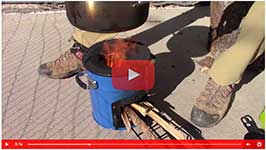
Recommended Reading
Best Fuel Storage Ideas: How To Store Extra Gasoline
Long term fuel storage is crucial in all survival situations, but fuels must be stored properly and safely to keep, especially long term gasoline storage.
How To Store Seeds For Wise Prepping & Survival
When seed saving and seed storage, you must do it right. Learn how to store seeds so they'll thrive the next planting season.
Common Everyday Carry Mistakes YOU Must Avoid At All Costs
The only person qualified to build YOUR Best Everyday Carry (EDC) is YOU. To do it right, you must avoid these common mistakes and pitfalls.
Strategic Relocation: How To Find A Safe Pace To Live
Use strategic relocation to find a safe, defendable location to call home. Your choice of location WILL determine your survival fate.
Map Of Nuclear Fallout: Would I Survive A Nuclear Bomb?
Have you seen a map of nuclear fallout? Or run a nuclear simulation to see the damage a nuke would do to your city? If not, check this out.
Homestead Survival: How To Master Plan Your Own Safe Haven
Use this simple 6 step action plan to successfully plan and build a homestead to survive (and thrive) even if the world falls into chaos...
